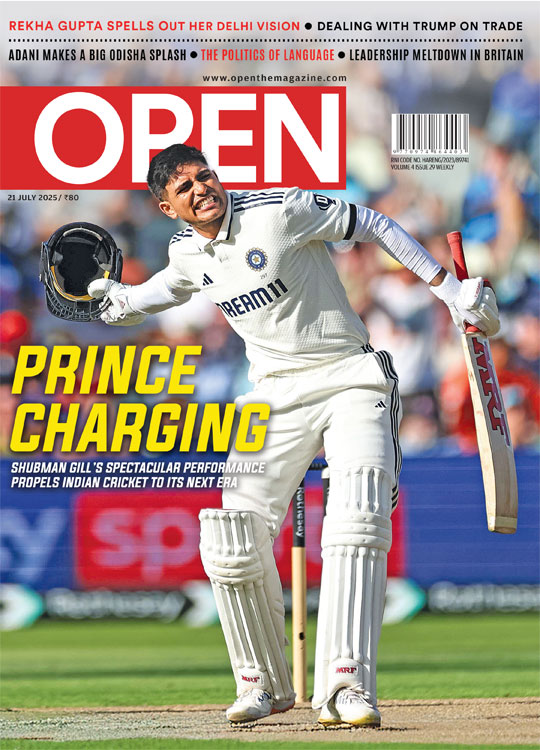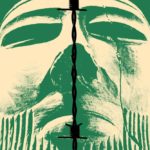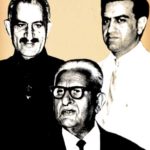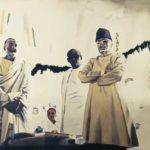The Other Mutiny: 1946 Naval Rebellion
Spare a thought for the heroes of the 1946 naval rebellion
 Pramod Kapoor
Pramod Kapoor
 Pramod Kapoor
Pramod Kapoor
 |
10 Aug, 2017
|
10 Aug, 2017
/wp-content/uploads/2017/08/Othermutiny1.jpg)
History, they say, is written by the victors. There are moments in time, however, when it becomes difficult to isolate the winners from the vanquished. Judged through a contemporary (and Indian) lens, the mutiny of February 1946 by naval ratings would certainly be one such. Though relatively unknown and largely unrecorded in military archives, the mutiny by naval ratings serving under the Royal Indian Navy (RIN), in February 1946 caused a major upheaval in the British establishment and, by all accounts, helped hasten India’s gain of Independence a year later. My upcoming book on the subject is titled 1946: The Unknown Mutiny, largely because very little is known about the events of that fateful week when the might of the British navy was challenged by a group of callow but idealistic young men. Just before dawn on February 18th, 1946, ratings posted on HMIS Talwar, a naval shore establishment in South Bombay, struck work, refused to eat and shouted slogans of ‘Quit India’, ‘Down with the British White Rats’, ‘Jai Hind’ and relayed signals to all within radio range informing them of the strike. The ratings were all young men, barely 17 to 24 years old, but they had lit the spark for what could be termed the Mutiny of 1946. For most people, the Indian mutiny refers to the one that took place in 1857 against the British East India Company, and posed a threat to the British Crown’s rule over India. The Naval Mutiny of 1946 was a courageous and audacious revolt by patriotic young men that spread like wildfire among the ship and shore establishments controlled by the RIN, spreading as far as Aden and Indonesia, and posed a major threat to the British rule because of its timing and circumstance.
In 1857, the mutiny was spearheaded by sepoys serving under the East India Company’s army. The one in 1946 was also initiated and manned by their equivalent in the navy, ratings. This was a time when the world, and especially Britain, was limping back from the devastation of World War II. At the start of the war, the British had recruited as many as 2,500 officers and nearly 22,000 sailors for the RIN and thrown them into the theatre of war. The RIN recruits excelled in their fighting role; with the recapture of Rangoon being one of their numerous naval victories. However, as the war ended, the ratings found themselves being treated shabbily and, having outlived their usefulness, reduced to the level of the dregs of military society. The war had drained the British coffers to the point of near bankruptcy and it could no longer afford to maintain such a large naval force of Indians. Demobilisation was enforced, using the harshest methods, with ratings handed two shirts, a mug and a one-way railway ticket back home. For those who were retained, working conditions deteriorated rapidly to the extent that they no longer had the luxury of beds, and dormitories that could barely accommodate twenty were filled with as many as fifty. The ratings were made to sweep floors, clean toilets and carry tea for the British officers. Religious sentiments were deliberately ignored and insulted. Racial abuses, discrimination and swear words became the order of the day. The food they were served was unpalatable with daal full of small stones and curries with more water than meat.
Torture and injustice often works as a powerful adhesive even when inflicted upon disparate groups with a common cause. The young ratings—Hindus, Muslims, Christians, Dalits, Brahmins, with different mother tongues, of all class and caste, were made to sit around a large wooden vessel full of indigestible daal, given half-cooked rotis, which they would dip into the common vessel and eat as a community meal. Irrespective of their religious and class differences, the act of breaking bread together made them brothers in arms. Inadvertently, the British naval officers had united them to turn rebels.
Students’ unions and mill workers too joined in the mutiny and hit the streets of Bombay, leading to arson, looting and vandalising of anything British. The retaliation was inevitable
Anger and resentment among the ratings started to grow. Unable to bear the daily humiliation, the ratings sparked the rebellion of February 1946 (In military terms, when five or more people attempt to change or overthrow a superior authority with common complaint is defined as a mutiny). Though the RIN rebellion in 1946 was started by a motley group of about twenty ratings who called themselves ‘Azad Hindi’, the mutiny spread rapidly to no less than 74 ships, from Aden to Indonesia, along with some 20 shore establishments and involved nearly 20,000 ratings. It began soon after sunrise on February 18th. Though it lasted for less than a week and was largely unsuccessful, it was enough to rattle the British and had them on the run.
The ratings were pulling down the British ensign and replacing them with Congress, Muslim League, and Communist Party flags. Those on the naval ships in Bombay harbour even trained 4” Bofors guns mounted on the ships at iconic buildings such as the Yacht Club, Gateway of India, and the Taj Hotel. This was a deterrent to prevent any possible attacks on the mutineers. Not just naval ratings, students’ unions and mill workers galvanised by the Communists, too joined in the mutiny and hit the streets of Bombay, leading to widespread arson, looting and vandalising of anything British. The retaliation was inevitable and nearly 300 civilians lost their lives and over 1,500 were injured when police opened fire. So intense was the anger against the British, and so rapid and widespread was the rebellion, that it took months before peace and sanity could return. For weeks Bombay was a ghost city. Officially, HMIS Talwar and nearby ships surrendered on February 23rd, but in Karachi the mutiny lasted till February 25th.
Warship HMS Glasgow that was asked to sail rapidly from Trincomalee to Bombay to crush the mutiny was greeted with black flags signifying surrender. Mutinous ratings were arrested and discharged, put in a concentration camp in Mulund, or given a one-way ticket to their home with a warning never to come back, while Bombay gentry partied hard with the British on the same ship till wee hours in the morning until they were forced out using water hose.
The surrender was the result of being caught between two forces—the British anxious to leave with their imperial power intact, and the Indian political leaders desperately waiting to take over. In the process, the ratings fell victim to both sides. It was a spontaneous uprising which had no appointed leader. Driven by the idea of freedom they had merely reacted as a group denied even the basic human rights. Yet, what they did collectively was an act of supreme courage and sacrifice. The rebellious nature of the ratings was evident in the surrender document, drafted by the Communist leader Mohan Kumaramangalam. It stated: ‘Our strike has been a historic event in the life of the nation. For the first time, the blood of the men in the services and the people flowed together in a common cause. We in the services will never forget this. We also know that you, our brothers and sisters, will not forget. Jai Hind.’
India of the 1940s was too sedate a place for RD Purie. In 1948, he smuggled himself out with the Indian Olympic team travelling to Wembley, London. He arrived in London penniless but had taught himself the art of playing piano
While this was largely a leaderless mutiny, all rebellions of this nature tend to throw up several heroes who surface at different times and play stellar roles. Those who started the mutiny were not the same as those who raised the level of engagement with the British. And those who surrendered were not necessarily the losers.
RK Singh, a member of the Azad Hindi group, ‘a dreamy youth more inclined towards Gandhian method’, wanted to do something more daring. In the armed forces those days, you could be demobilised, sacked, or discharged. You could not resign. However, in an act of defiance, RK Singh sent in his resignation. When asked to explain before a committee of officers he threw his cap on the ground and kicked it showing his utter contempt for the crown. He was arrested and sent to the Arthur Road jail. MS Khan, another member of the Azad Hindi, was chosen the president of the Naval Strike Committee because of his suave personality and better command over English language. He was from Daska near Sialkot, now in Pakistan. He was grilled by the commission of enquiry. When asked as to why they were complaining about the service conditions when they were allowed the use of club facilities and dance with women, his reply was, ‘Sir, you can’t dance with water in your hand.’ Madan Singh, the vice president of the strike committee was a clean-shaven Sikh from Siar village near Ludhiana. Together with other members of the group they took control of Butcher Island, which was an ammunition dump for Bombay Presidency, and challenged the British officers. There are numerous such stories of individual courage that keep surfacing as I go on in my quest of knowing more.
This story and my eventual book 1946: The Unknown Uprising is a result of piecing together narratives left behind by participating individuals, court of enquiries, intercepted intelligence reports, newspapers of the time, etcetera. The book will be largely based on these primary sources. The nature of the mutiny was such that each time I have delved into my research, I have unearthed material that has thrown up a new hero or even a few new villains. In my view, there are four main protagonists or antagonists, depending upon the side you are. This is their story.
Rishi Dev Purie was one of the first to summon the courage to register an act of rebellion against the British. He performed the daring act of writing patriotic and anti-British slogans and chose an appropriate day, December 1st, 1945, also celebrated as Navy Day. RD Purie’s act of defiance proved to be an inspiration for many others to follow. For the British naval brass, Navy Day 1945 was special. They had, for the first time, decided to throw open Naval establishments to civilians. The who’s who of Bombay and nearby areas was invited to witness the pomp and ceremony of the Royal Indian Navy. The night before, Deb, as RD Purie was called by his fellow sailors, along with few other colleagues painted the walls of HMIS Talwar with slogans like ‘Quit India’, ‘Revolt Now’, and ‘Kill the British’. British flags were burnt, brooms and buckets put on the ship’s masthead and the entire establishment was turned into shambles. Deb was one of the main suspects, but the authorities could not find any proof against him. Nevertheless, he was discharged from the navy.
Commander Arthur Frederick King was a no-nonsense officer brought in to put fear and discipline in HMIS Talwar. King wasted no time in enforcing his authority
RD Purie, alias Harry, was the son of Dasaundhi Ram Purie, a resident of Model Town, Lahore, where he was born. He had served in both the army and the air force before joining the navy on July 22nd, 1944. He was discharged from the navy on March 24th, 1946, on the suspicion of writing subversive slogans on Navy Day. Sensing he would be in trouble, his older brother asked him to come to Simla and manage the popular, upmarket Davicos restaurant located on The Mall. Deb remained in touch with his fellow seamen including BC Dutt and others who had taken active part in the Naval uprising. As per intelligence records, while he was in Bombay, he had a romantic liaison with Shila Prasad, sister of Kusum Nair, and even after he was asked to move to Simla by his brother, the two exchanged letters regularly. Each of these letters was intercepted by the Intelligence Bureau. But for these letters the courage shown by RD Purie, alias Deb, alias Harry would have remained part of folklore known only to his friends and family. In one of the letters addressed to Shila Prasad, written barely four months after the Navy Day adventure, he says, ‘I am not suited for the army under the imperial flag. My blood is for I.N.A. and if someone can take me now I am out for it. Now I shall never join any force unless it is hundred per cent our own national force. Suppose there is a war now and I am called up again as I am still under the contract of ten years and temporarily released. I shall not join but prefer a cell behind the imperial bars.’
Influenced by comrade Kusum Nair and PN Nair, RD joined their revolutionary organisation, Indian Ex-Servicemen Association, headquartered in Bombay, and stayed in touch with them. A happy-go-lucky bon vivant, RD loved the good life. An attractive man with rakish charm, he had women in high society falling all over him. The India of 1940s, however, was too sedate a place for him. In 1948, he smuggled himself out with the Indian Olympic team travelling to Wembley, London. He arrived in London penniless but had taught himself the art of playing piano while running Davicos in Simla. He became a professional piano player, performing in clubs and restaurants. Later, his brother set up a film distribution company for him in London. There in the mid-50s he met his future wife Nicole, a Frenchwoman with whom he had two daughters. One of them, a stewardess with Air France, still visits Delhi often. Later, he and Nicole got divorced and RD returned to Delhi. Many still remember meeting him at the India Today office which was owned by his elder brother VV Purie, father of Aroon Purie and Madhu Trehan. RD had also worked with India Today in its formative years and travelled with its then editor, the late Chhotu Karadia, to many places including Pakistan. Rishi Dev Purie passed away in Delhi in 2014, aged 91.
Commander Arthur Frederick King (2 October 1917 – 7 November 2014) was described as the man who lit the ‘spark that kindled the fire’ of the rebellion. King took charge as commanding officer of HMIS Talwar from Commander ATJ Cole on January 21st, 1946. Cole was hugely popular, particularly with the Indian ratings and was seen as being too lenient and sympathetic towards the Indians when the issue of writing anti-British slogans became a concern. In contrast, King was a no-nonsense officer who was brought in to put fear and discipline in HMIS Talwar the signal school, a shore establishment, then the second largest in the British Empire. King wasted no time in enforcing his authority. On February 8th, a day after his car was painted with ‘Quit India’ slogan and its tyres punctured, he decided to make a surprise visit to the naval barracks early in the morning. The ratings ignored him and did not get up or salute him. Enraged, he shouted, ‘Get up, you sons of coolies’ and ‘you sons of Indian bitches’. Discontent was simmering among the ratings for some months. And this abuse acted as the last straw. The ratings complained orally to higher authorities but their complaint was passed back to Commander King, who ordered them to take back the complaint or face the consequences. For a week, no action was taken. Then, on February 16th, BC Dutt, the lead telegrapher, was arrested for writing seditious slogans on the walls of Talwar. The next day when the ratings complained about unpalatable food, the duty officer yelled, ‘Beggars can’t be choosers’. The following day they struck work. That evening their strike was declared as mutiny. Sensing trouble, the authorities immediately transferred Commander King. (However, not in disgrace since he was put in charge of the Mulund camp where 200 suspected ringleaders of the mutiny were held.) He drove some of the prisoners he had personally known to the railway station in Thane, gave them one-way ticket and ordered them never to come back.
After Independence, he was offered a senior position both by India and Pakistan. He declined and joined a private company, manufacturing figs, syrups, salts and above all the well-known pain relieving drug, Panadol. He retired in 1982. He was one of the last surviving members of the Royal Indian Navy Association. In 1997, he organised the last ‘Tamasha’ as the grand show of RIN was called. In 2004, after much persuasion, he visited India and was welcomed and felicitated by many of those ratings and officers who had risen to higher ranks; a few had become admirals. He passed away in 2014, aged 97. He is survived by a daughter, Jennifer.
BC Dutt was placed in solitary confinement for 17 days, then demoted and discharged from the navy. Upon release, he was greeted like a hero by fellow ratings. The Royal Indian Navy, however, considered him a traitor
Balai Chandra Dutt was born in 1923 and was a matriculate and just 18 years old when he joined the Royal Indian Navy. Recruited as a trainee wireless telegraphist, he saw action in Burma during World War II and was subsequently assigned to the shore establishment, HMIS Talwar, located in Wodehouse Road, Colaba. It was here that he met an old friend, Salil Saran, returning from Burma, who had brought back letters written by members of Azad Hind Fauj, addressed to Jawaharlal Nehru and Sarat Chandra Bose (elder brother of Subhas Chandra Bose). He was looking for a way to deliver them. In those days, it was considered high treason if caught with such letters. It was like holding a live bomb. In their free time, or ‘Liberty’, the ratings would congregate in civilian areas where they would read and share stories about the courage and defiance of Subhas Chandra Bose, the INA, and their unjust trial in 1945. Soon they formed a group of like-minded young patriots and called themselves Azad Hindi. They would meet clandestinely and make plans to help gain the country’s freedom. Kadam Kadam Badhaye Ja became their inspirational song. After RD Purie’s success on Navy Day, their courage had grown, and they decided to strike again. They chose February 2nd, the day the Commander- in-Chief’s maiden visit to Talwar was scheduled. Surveillance had quadrupled, but taking advantage of the darkness, Dutt painted ‘Quit India’ and ‘Jai Hind’ on the wooden platform from where the C-in-C was to address the officers and men. He stuck similar seditious leaflets on the walls of the barracks. He was caught with paint and a gum bottle in his possession. His locker was opened where more seditious literature was found. Dutt was placed in solitary confinement for 17 days, then demoted and discharged from the navy. Upon release, he was greeted like a hero by fellow ratings. His name and exploits were splashed all over the nationalist press like the Free Press Journal and Bombay Chronicle. The Royal Indian Navy, however, considered him a traitor. Under police escort, BC Dutt was taken to Calcutta. He was given six rupees while his legitimate due after serving for five years, was six hundred rupees. Dutt had no intention to go to Calcutta. Bombay was his city. Midway through the journey in Igatpuri, he gave his escorts the slip and returned to Bombay. S Sadanand, the legendary chief of the Free Press Journal, gave him a reporting job. Soon, Dutt got disillusioned with journalism and left to join the leading advertising firm Lintas. While at Lintas, he wrote his memoir Mutiny of the Innocent. It was edited and rewritten by his colleague Shyam Benegal, the acclaimed filmmaker. The socially popular Dutt married Anasuya, who eventually became a top senior lawyer specialising in divorce cases. She practiced actively until the late 80s and was considered one of the best legal minds in Bombay. With perseverance and a bit of snooping, I traced Anasuya Dutt to her flat in South Mumbai. I was given half an hour by her son Anuj to talk to her one afternoon. A charming lady in her early nineties, she replied to most of my questions with a childlike smile. I chatted with her till I was told that she was too tired and that she would have answers to all my questions if I could come the next day same time in the afternoon. Next morning, I got a call from Anuj that his mother could not sleep the whole night muttering incoherently about ‘mutiny’ and had to be hospitalised.
Admiral John Henry Godfrey (10 July 1888 – 29 August 1971) was appointed Field Officer Commanding Royal Indian Navy (FOCRIN) in 1943. He was the chief of Royal Indian Navy when the mutiny took place in February 1946. Admiral Godfrey had an impressive career before coming to India. From a cadet in 1903 he rose to become youngest commander in the Royal Navy aged 32. He was promoted to Director of Naval Intelligence in 1939, one of the most sensitive positions during World War II. He worked closely with Winston Churchill, though not always agreeing with him. He had a 90-minute meeting with American President Franklin D Roosevelt at the peak of the war, which resulted in the setting up of a joint intelligence group. Godfrey, director of naval intelligence at the time interviewed Ian Fleming, the creator of James Bond 007, in May 1939 for a job as his assistant and together they made a formidable team in intelligence gathering. Godfrey treated Ian Fleming as a son he never had and was so fond of him that he once remarked, “Ian should have been the Director of National Intelligence, and I, his Naval adviser.” Ian Fleming on his part based the character of James Bond’s boss ‘M’ on Rear Admiral Godfrey.
Admiral Godfrey interviewed Ian Fleming, the creator of James Bond 007, in May 1939 for a job as his assistant and together they made a formidable team in intelligence gathering. Fleming, on his part, based the character of James Bond’s boss ‘M’ on Godfrey
Godfrey arrived in India in March 1943 for a three-year term. He made some significant contributions to naval reforms in India but eventually had to handle the difficult job of demobilisation post World War II. There were over 27,000 ratings in the RIN when he took over. His job was to bring them down to 11,000 by cutting almost 500 jobs every week. This inevitably led to an acute sense of discontentment among the Indian ratings. This was, in fact, one of the main reasons for the mutiny of February 1946. There were obviously other factors—the sense of patriotism and freedom arising out of the INA trials at Red Fort in Delhi, poor service conditions, bad food, and racial discrimination. It all added up to a potent and volatile mix.
Godfrey was at Udaipur airport when he got the news of the rebellion. He writes in his memoir: ‘As we drew into Udaipur I noticed an RAF plane on the airfield. This looked a bit ominous… I saw Kirkbride, the Resident, standing on the platform with a sealed envelope. The letter informed me that a mutiny had broken out in Bombay… I flew to Delhi that afternoon and on to Bombay on 20 February.’
Ignoring his chief Field Marshal Claude Auchinleck’s suggestion, Godfrey asked his next in command Rattray to continue a dialogue with leaders of the strike committee while at the same time, preparing to crush the rebellion with an iron fist, if needed. He made this clear in what is now an infamous broadcast to the ratings on the afternoon of February 21st. In this broadcast, which was widely criticised even by the British and Indian leaders of the time, he said: ‘I want again to make it quite plain that the government of India will never give in to violence. To continue the struggle is the height of folly when you take into account the overwhelming forces at the disposal of the government… which will be used to their uttermost even if it means the destruction of the navy of which we have been so proud.’
Eventually, the mutiny was countered with excessive force, but Godfrey was replaced the very next day and faced the humiliation of having to report to his junior. Godfrey returned to Britain in March 1946. After his retirement, he was chairman of several hospitals and founded a centre for spastic children in Chelsea. He was awarded order of the Nile of Egypt and made a chevalier of the French Legion d’Honneur. Admiral Godfrey died in Eastbourne, UK, in 1971.

/wp-content/uploads/2025/07/Cover-Shubman-Gill-1.jpg)













More Columns
Shubhanshu Shukla Return Date Set For July 14 Open
Rhythm Streets Aditya Mani Jha
Mumbai’s Glazed Memories Shaikh Ayaz